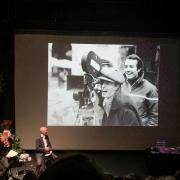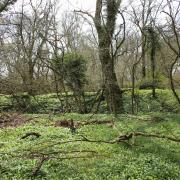Kate Adie’s new book explores for the first time in detail the vital role women played during World War One. Here, the nimble-fingered net-making women of Bridport are called upon to provide everything from hay nets for horses on the front line to anti-submarine nets to stop German U-boats invading our shores.
The War Office was pointing its big finger at Bridport, saying The Country Needs your Nets. It had a phenomenally lengthy list of specialized demands for the industry, and the numbers involved made everyone gasp. (A few miles away in Somerset, the Taunton firm of Fox Brothers, already producing military khaki serge, received an order for army puttees – the cloth strip wound round soldiers’ legs. The War Office wanted 852 miles of it. They went on to manufacture over eight thousand miles of cloth.)
The orders came through for nets, not by the dozen or the gross but in millions. Every man in the army needed a rifle pull-through cord; hundreds of thousands of lanyards were necessary, and grenades demanded hundreds of thousands of whip-cord safety-pin rings. All were small, fiddly jobs at which the women were expert. The military used nets for transporting equipment and carrying stores, and potato- and pea-nets for boiling vegetables: thousands of them. The navy wanted braided hemp lanyards, plaited and twisted, which sailors wore –and put the number in six figures. As sailors still slept in hammocks, more hammock clews were anticipated, plus nets for fishing at sea.
And as the orders piled up, hundreds of Bridport men – no different from anywhere else in the country – were enlisting to fight. There was enthusiasm to join the Dorset Yeomanry, the Bridport Volunteers, the Dorset Regiment and the local Garrison Artillery: you joined up with men you knew, with your pals, and the rural areas supplied more than their fair share of volunteers. In the first few months seven hundred were gone and eventually over sixteen hundred joined up, from a town of just over six thousand people.
Unexpectedly, a potential new workforce arrived in the shape of Belgian refugees, who were being dispersed from London because of the huge numbers needing accommodation. Bridport opened its doors and the first group to arrive were clearly impoverished, clutching only a few bundles of belongings. They needed to work and the rope-sheds immediately took on men as labourers. The women were taught the rudiments of knotting and splicing and soon joined the other net-makers.
Even so, the War Office was making unheard of demands and had reached a hay net crisis. The usual local hay net production had been geared to the occasional request from farmers and local hunts; the War Office was asking for six hundred thousand, followed by eight hundred thousand and finally a million. Used to dealing with both suppliers of raw materials and exports on an international basis, the net and rope firms went to their usual sources only to realize that the war was an obstacle on the trading routes. Local hemp had not been grown in any quantity for years, so Russia and Italy had kept Bridport supplied with high-quality material. But ships could no longer safely get through from Russia because of German submarine activity. In Italy, the advance of the Austrians towards the River Po in the north had the militarily unnoticed effect of threatening the best hemp-fields in the world around Ferrara. The British Flax and Hemp Growers’ Society found itself recruited to the war effort with demand growing from the army for tents, tent lines and kitbags, and from the Royal Flying Corps for nets for balloons –not to mention linen shirts for airmen. The women spinners and weavers in the linen mills of Belfast were working flat out producing army shirts, knapsacks and stretchers. What had been a gently declining industry had suddenly burst into life again.
In the search for extra supplies manila twine (a relative of the banana plant) was found to be available, strong and pliable, so manila hay nets were despatched to the picket lines in France. The soldiers on duty duly stuffed them with hay and left their horses to munch in peace. They returned the next morning to find no trace of the nets. A thorough search ended with the obvious conclusion that the horses had found the manila absolutely scrummy; no more manila nets were ordered.
Hemp- and flax-growing questions occupied a considerable amount of parliamentary time, with sources being scoured for seed and production in Ireland expanded. Meanwhile, at least fifty thousand hay nets per week were leaving Bridport and by 1917 nets were being used to camouflage guns and equipment stores; the looms were in full production and the hand workers took on more work.
There is very little evidence that the women found themselves flush with generous wages – their sister workers in the linen industry in Northern Ireland were some of the worst paid anywhere. The Dorset women were neither unionized nor could they call on any national organization to help them, and they seem to have been overlooked in many of the war’s reports into women’s work. However, as production increased to a point where the navy’s lanyards were no longer counted (they were in millions) but weighed, the government realized that the outworkers and braiders should be recognized as being on essential war work and protected from being sent to the Land Army which was also desperate for labour.
The production figures seem extraordinary, but the old payment ledgers offer evidence of the industrious energy of individual workers who were certainly not sitting amongst the hollyhocks in the sunshine, knotting the occasional net by hand.
In May 1916 twenty-two-year-old Lily Read in the village of Loders was managing an average of five dozen hay nets a week, though she was not earning a fortune at a shilling a dozen. A year later, her work rate had increased to around twelve dozen, bringing her ten shillings –half the average pay of a woman factory worker. Just along the lane was Rebecca Northover, married to a carpenter and with six children, who would hardly be living in the lap of luxury. She was making pea nets, hay nets and hammocks; a seven-foot hammock brought her fivepence, so her week’s income for sixteen of them was six shillings and eightpence (33p).
The lack of pictures of these war workers – in comparison to those in munitions, engineering and transport – and the reticence of the local press to cover an industry which had consumed the energies not only of the town but of a score of outlying villages, may well be due to the other kind of net that was being made in the town. It was another secret weapon: the anti-submarine net.
Reader Offer
Fighting On The Home Front – The Legacy of Women in World War One by Kate Adie is published by Hodder and Stoughton at £20.
To order your copy of Fighting on the Home Front at the special price of £13.00 (rrp £20.00) including postage and packing please send cheque payable to Sparkle Direct and send to Hodder Headline Offers, PO Box 60, Helston, TR13 0TP. Alternatively you can order on line at sparkledirect.com or call 08430600037 and quote ref ‘ENTER BKP REFERENCE’. Offer ends 30 November 2013.



























